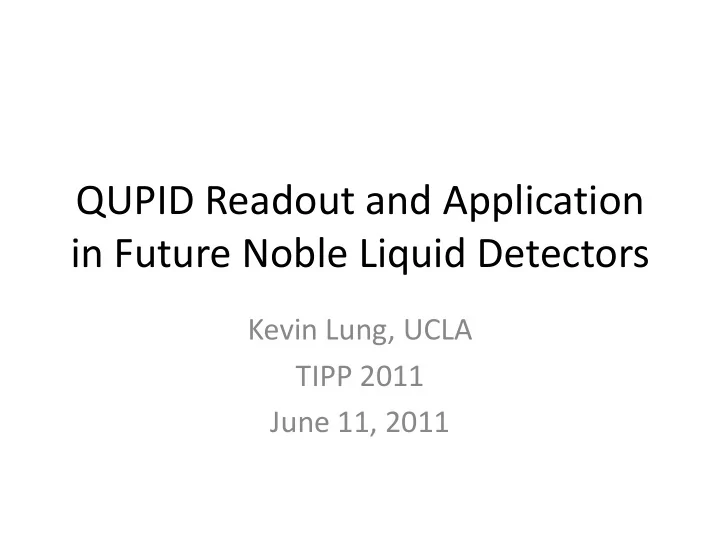

QUPID Readout and Application in Future Noble Liquid Detectors Kevin Lung, UCLA TIPP 2011 June 11, 2011
06/10/2011 Kevin Lung, UCLA 2
Overview • QUPID Introduction • Developments at UCLA • Power Supply • Readout Overview • Future Detectors 06/10/2011 Kevin Lung, UCLA 3
Backgrounds in Current Experiments Cosmic Rays Underground or Under high mountains Radio Activities (U, Th, K, Co, …) XENON100 Detector Water Tank/ Liquid Scintillator/ Shield Photon detectors are the major source of backgrounds. 06/10/2011 Kevin Lung, UCLA 4
QUPID 06/10/2011 Kevin Lung, UCLA 5
Comparison of Photon Detectors R11065 QUPID R11410 3 inch QUPID – 3 inch lowest R8520 radioactivity 1 inch per area arXiv:1103.3689, arXiv:1103.5831 238 U 226 Ra 232 Th 40 K 60 Co Phototube Effective Area Units 6.5 cm 2 mBq/cm 2 R8520 <2.3 <0.056 <0.070 2.2 0.10 32cm 2 mBq/cm 2 R11410-MOD <2.9 <0.076 <0.082 0.42 0.11 32 cm 2 mBq/cm 2 QUPID <0.54 0.010 0.012 0.17 <0.0056 Screening at the Gator facility in LNGS, by the University of Zürich. 06/10/2011 Kevin Lung, UCLA 6
QUPID, the QUartz Photon Intensifying Detector 06/10/2011 Kevin Lung, UCLA 7
Bombardment and Avalanche Gain • Bombardment gain at -6 kV is ~750; temperature independent • Typical avalanche (APD) gain is ~200; temperature dependent Avalanche Bombardment • This results in a total gain of >~10 5 Single Photoelectron detection requires ~5x10 6 gain • 06/10/2011 Kevin Lung, UCLA 8
Single Channel Readout Schematic 06/10/2011 Kevin Lung, UCLA 9
Single QUPID Testing & Operation • QUPID fully characterized in liquid nitrogen cooling system from room temperature down to LXe, LAr temperature. (see talk A.Teymourian) • QUPID operation in LXe system; observation of xenon scintillation light LXe system Radioactive sources 06/10/2011 Kevin Lung, UCLA 10
Current Developments at UCLA • Building several cryogenic systems to test and measure multiple QUPIDs at once • 7-QUPID Systems at UCLA – Gas Nitrogen – Liquid and Gas Xenon – Liquid and Gas Argon 06/10/2011 Kevin Lung, UCLA 11
06/10/2011 Kevin Lung, UCLA 12
Multi-Channel Qupid Readout Schematic RFBayInc LNA-1440 Digitizer Decoupling Box CAEN 10 nF v1720 CAEN v1720 100 k Power Supply Board Fermilab Development 500 M APD HV EMCO CA10N Netburner Mod5270 Photocathode HV EMCO C80N 06/10/2011 Kevin Lung, UCLA 13
High Voltage Power Supply in Development at Fermilab Regulated Power Supply with proportional voltage control R&D design by Fermilab will support high 0 to -1000 V for APD voltage supply to two QUPID channels Ripple p-p<0.001% ->avalanche gain stable within 1% 0 to -8000 V for cathode Ripple p-p<0.2% -> bombardment gain stable within 1% Power Supply Board Fermilab Development Computer Control and monitoring Netburner Mod5270 APD HV EMCO CA10N 12-bit DAC Netburner Ethernet interface Mod5270 Control proportional input and measure Photocathode HV proportional output EMCO C80N Monitor current 06/10/2011 Kevin Lung, UCLA 14
Board Prototype Netburner Mod5270 Cathode High Voltage Module APD High Voltage Module Picture from Mike Utes, 06/10/2011 Kevin Lung, UCLA 15 Fermilab
Multi-Channel Qupid Readout Schematic RFBayInc LNA-1440 Digitizer Decoupling Box CAEN 10 nF v1720 CAEN v1720 100 k 500 M APD HV EMCO CA10N Netburner Mod5270 Photocathode HV EMCO C80N Power Supply Board Fermilab Development 06/10/2011 Kevin Lung, UCLA 16
Multi-Channel Qupid Readout Schematic RFBayInc Single Cable from APD LNA-1440 Digitizer Decoupling Decoupling of signal and Box APD high voltage CAEN 10 nF v1720 Dual channel signal readout system CAEN v1720 Increase dynamic range of 100 k detector Allows for probing of low and high energy phenomena Amplifier Requirements for dark matter High gain: 30 - 40 db Wide bandwidth 100 KHz - 1 GHz Primary scintillation signal Ο(ns) to Ο(μs ) Ionization signal Ο(μs ) Low noise for single photoelectron detection 06/10/2011 Kevin Lung, UCLA 17
Amplifier • Commercial – RFBay Inc. LNA1440 – Bandwidth 10 KHz-1.4 GHz – 40 dB gain – Single channel • Custom, in development – based on a design used by the MAGIC collaboration (P. Antoranz – PhD thesis) – 8-channel capability – ~35 dB gain – Modified for the frequency range desired ~100 KHz - 1.4 GHz – Will include decoupling and dual channel output 06/10/2011 Kevin Lung, UCLA 18
Digitizer • 8-Channel 12-bit CAEN v1720 will be used to digitize the QUPID signal • Sampling frequency of 250 MHz provides sufficient time resolution for scintillation signals in noble liquid • Circular buffer allows for no deadtime • Allows for high rate acquisition for calibration 06/10/2011 Kevin Lung, UCLA 19
Future Dark Matter Detectors DarkSide50 - Dual Phase LAr TPC XENON1T - Dual Phase LXe TPC 19+19 QUPIDs 121+121 QUPIDs • MAX – Multi-ton Ar&Xe detector 06/10/2011 Kevin Lung, UCLA 20
Conclusion • QUPID Concept – new hybrid photodetector with low radioactivity • Development of multichannel QUPID systems – Power supply with computer control and monitoring is in development – Single channel commercial amplifier for testing, custom 8-channel amplifier for the future – Multichannel digitizer for dual channel output • QUPID in future low background noble liquid detectors 06/10/2011 Kevin Lung, UCLA 21
Acknowledgements • XENON100 Collaboration • DarkSide50 Collaboration • MAX Collaboration • Hamamatsu Photonics • Fermilab • “Characterization of the QUartz Photon Intensifying Detector (QUPID) for use in Noble Liquid Detectors” arXiv:1103.3689 • “Material screening and selection for XENON100” arXiv:1103.5831 06/10/2011 Kevin Lung, UCLA 22
Recommend
More recommend